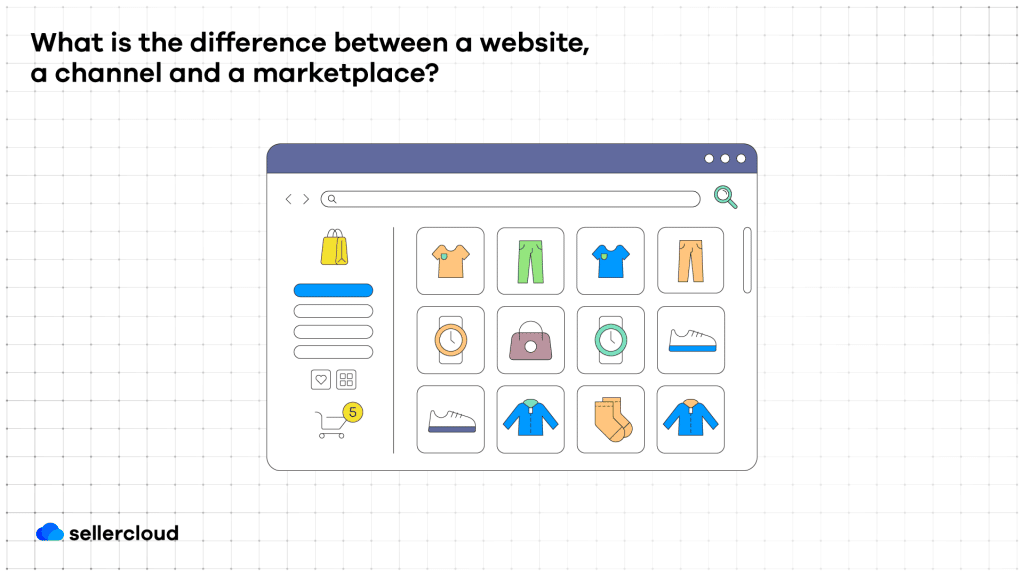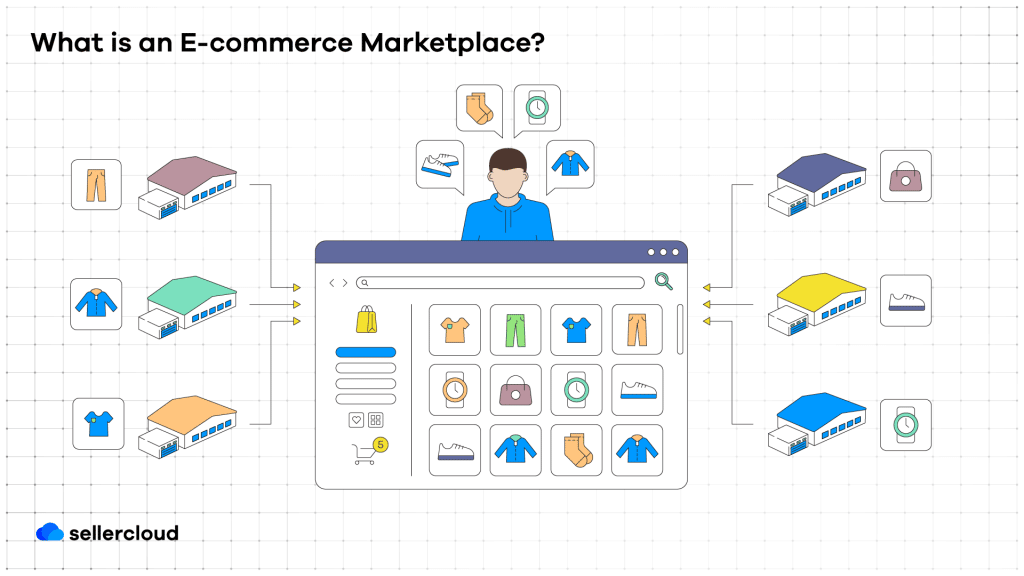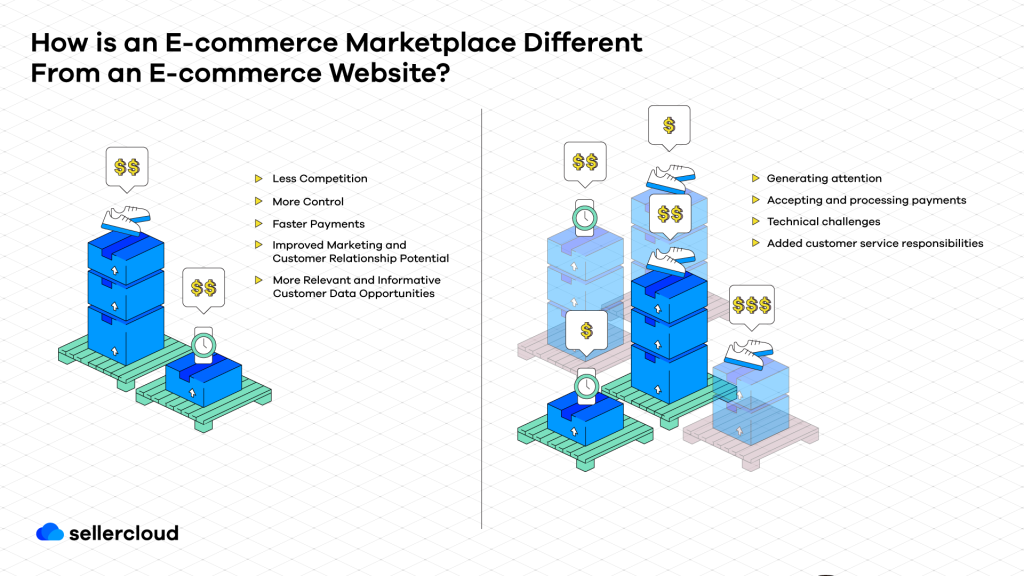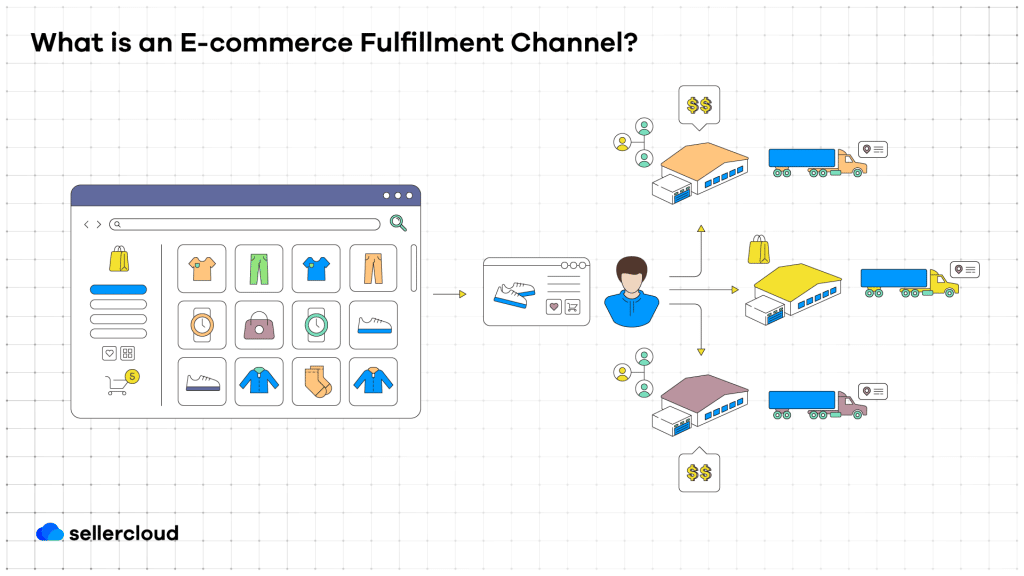
Ecommerce is a profitable and dynamic way to grow a retail business. That said, ecommerce can take on many different forms depending on what, where, and how a business chooses to market and sell its products.
The direct approach involves a business creating and maintaining a first-party ecommerce website where products are listed and sold directly to customers. This comes with notable amounts of upkeep and responsibility, but it can pay off big for businesses looking to maintain control over every aspect of their marketing and sales.
Alternatively, some businesses opt to list products on third-party ecommerce marketplaces. These shopping destinations, including popular sites like Amazon, eBay, Walmart Marketplace, and Etsy, are established landing pages for customers looking to buy online.
They are also rife with competitors and compliance expectations for sellers. For many businesses, it isn’t an either/or situation. Many choose to adopt hybrid, multichannel approaches leveraging a combination of first- and third-party sales opportunities.
As with all things ecommerce, there is no one-size-fits-all answer to which approach is ideal for your business. To truly know what is best for your online sales, you must understand and assess the differences between marketplace-based ecommerce and first-party website sales.
From there, you must also consider what fulfillment support, if any, is required to ensure you can deliver for your customers.
What Is an Ecommerce Marketplace?
An ecommerce marketplace is a centralized online shopping hub where various brands and sellers create digital stores to sell products to customers. While each of these marketplaces has its own approach to online sales, they all share many of the same operating principles.
Customers visit the websites of these online marketplaces and search or browse for items and products. The marketplaces use their own data and algorithms to surface relevant listings and product categories.
The customer is then free to comparison shop across the stores of multiple sellers. When a purchase is made, the marketplace serves as the middleman, accepting the customer’s payment and passing the order details to the corresponding store owner for fulfillment.
In exchange for facilitating the sale, the marketplace charges a fee of some type. These marketplace fees commonly include a commission based on the sale price, a listing fee, and/or a subscription fee.

From there, the seller is responsible for ensuring that the customer receives the product they ordered in the appropriate condition and within an acceptable time frame. This can be done piecemeal, order-by-order, or with the support of a fulfillment channel partner (more on this later).
If a seller cannot comply with the expectations and terms of service of a marketplace, it can lead to a seller being suspended or removed from the platform. This makes logical sense. An unhappy customer is unlikely to return to make future purchases, negatively impacting the marketplace’s bottom line.
Therefore, sellers must remember that the customer base is one of the most valuable commodities in an ecommerce marketplace. It is a key factor that attracts sellers to a platform and, simultaneously, a critical source of marketplace revenue. For this reason, a marketplace often prioritizes its customers over its sellers.
Ecommerce Marketplaces Generate Profitable Opportunities for Committed Sellers
There is a reason why ecommerce businesses opt to list and sell products on online marketplaces: it’s an undeniably effective retail strategy. For ecommerce sellers just getting off the ground, the ability to tap into a marketplace’s existing customer base can prove invaluable. To these ends, most marketplaces have a low barrier to entry, making it easy for sellers of all sizes to start selling quickly.
Similarly, established businesses and brands often turn to marketplaces to expand their product reach as part of a multichannel or omnichannel strategy. Whether a seller sells a single item or an entire SKU product line, ecommerce marketplaces represent a valuable pathway to scaling online retail efforts.
However, success is not as simple as listing items and waiting for the orders to roll in. Just as brands compete for shelf space in brick-and-mortar retail environments, sellers on ecommerce marketplaces must compete for search rankings and customer attention.
Success depends on making the right SEO choices (which can vary from marketplace to marketplace), pricing items competitively, and earning positive customer feedback. Businesses that commit to these goals and optimizations have an outstanding opportunity to get noticed and drive sales on ecommerce marketplaces.
How Is an Ecommerce Marketplace Different from an Ecommerce Website?
Despite their advantages, ecommerce marketplaces are not always the ideal sales channel for some brands and products. In some cases, high rates of competition or even elements of the marketplace experience itself inhibit important aspects of online retail growth.
Enter ecommerce websites. Rather than relying on a third-party company to facilitate an online sale, companies can (and should) invest in a first-party website to sell directly to customers (DTC) without a third party in the middle.
To do so, there are several key considerations that sellers who rely exclusively on marketplaces do not typically contend with:
Generating Attention
Marketplaces attract customers by offering a wide variety of products, a familiar shopping experience, and competitive prices. They serve as the digital equivalents of a brick-and-mortar department store or mall.
Ecommerce websites are more like boutiques dedicated to a singular product or brand. The entire shopping experience is self-contained, and on-site competition can be entirely eliminated.
The downside is that, unlike marketplaces, which are established shopping destinations for many customers, ecommerce websites need to do extra work to get customers through the virtual door. Customers are less likely to visit a business’s first-party website without some degree of shopping intent beforehand.
This means businesses must invest time and energy into marketing efforts like search engine optimization (SEO), online advertising, and brand development to attract customers to an ecommerce website. Customer acquisition must always be front of mind.

Accepting and Processing Payments
One major perk of selling on a marketplace is that the marketplace usually handles customer payments. This typically affords additional layers of protection to ensure that transactions are completed smoothly and sellers are paid.
Likewise, marketplaces help facilitate returns and exchanges to ensure that money and products flow in the proper directions. Conversely, sellers that sell on a first-party website need to have their own secure payment gateways and point-of-sale (POS) systems in place to be able to accept customer payments.
There also needs to be clear and responsive reverse logistics procedures in place for customers to initiate and complete returns.
Technical Challenges
Registering for an ecommerce marketplace is, in most cases, a quick, straightforward proposition. First-party ecommerce websites, on the other hand, require securing domains, coding web pages, honing the on-site user experience, integrating services from third-party partners, maintaining site and data security, and regular maintenance.
Several website platforms like Magento, Shopify, BigCommerce, and WooCommerce can simplify many of these elements; however, sellers still need a dedicated technical team to ensure their site is set up and running smoothly.
Added Customer Service Responsibilities
While marketplace sellers must be quick with their customer response time to avoid punitive actions, responsiveness is just as important on first-party ecommerce websites (if not more so).
Sellers must make it simple for customers to contact them about products and issues, and, on the other hand, be prepared to respond with quick, customer-focused solutions. Failure to do so can make all the extra customer acquisition efforts in vain and hamstring a business’s prospects to scale its website’s sales potential.
Advantages of Selling on a First-Party Ecommerce Website
Despite these challenges, there are some noteworthy advantages to selling on a first-party ecommerce website:
Less Competition
A first-party website features only the products, brands, and sellers the website owner wishes to feature. This allows for a level of insulation against the on-site comparison shopping that sellers face on third-party marketplaces. This opens the doors to sales-boosting opportunities like onsite cross-selling and upselling.
More Control
As mentioned, an ecommerce web page serves as a self-contained online boutique. Businesses can customize every facet of the customer experience, including the site design, featured media, listing copy, product organization, and more.
This is in stark contrast to the often rigid rules and limits placed upon sellers’ storefronts and product pages on ecommerce marketplaces. This freedom sets the table for layers of brand development and customer-focused decision-making, often inhibited on third-party sales channels.
Beyond brand development, running an online store outside the confines of a marketplace means that sellers can integrate third-party partners, services, and systems as they see fit. These integrations can provide various benefits, including fulfillment support, inventory management, warehouse management, and more.
In many cases, these types of integrations can simultaneously boost the convenience and profitability of an ecommerce business’s first-party sales efforts.
Faster Payments
Marketplaces traditionally make sellers wait for scheduled payout dates. This allows the marketplaces to hold on to sellers’ profits for a period of time to safeguard against customer complaints, returns, or other order issues. This is not an issue for first-party website sellers. When customers pay, the money is available as soon as it clears.
Improved Marketing and Customer Relationship Potential
Communicating directly with customers is a tightly controlled proposition in ecommerce marketplaces. Contact is usually limited to on-site channels to prevent communications that could compromise the marketplace’s integrity or circumvent the marketplace’s control entirely.
First-party ecommerce websites do not have such restrictions. This allows us to explore direct marketing and customer relations management strategies more deeply, which can foster repeat business and brand loyalty.
More Relevant and Informative Customer Data Opportunities
Of course, effective brand development and omnichannel marketing strategies require sellers to have an intimate knowledge of their customer bases. While many marketplaces offer dashboards with curated customer data, there are even greater opportunities for data collection on a first-party ecommerce website. The knowledge gained can fuel customer acquisition and retention strategies based on business intelligence rather than following hunches and instincts alone.
There are certainly challenges in establishing and running a first-party ecommerce website, but removing the restrictions and limitations imposed by third-party marketplaces opens up avenues for marketing and customer relations management that can help online retailers of all sizes scale and grow.
What Is an Ecommerce Fulfillment Channel?
Whether a seller converts a sale on a third-party marketplace or through a first-party website, they need to have a way to get products from their door to their customers. This means picking, packing, and shipping every order efficiently and reliably, whether it originates from an ecommerce marketplace or a first-party website.
Sometimes, it makes fiscal and logistical sense for some sellers to handle this in-house. Combining the right warehouse locations, workflows, staffing, and warehouse management system (WMS) can ensure that inventory is properly accounted for and orders are handled efficiently. In these cases, arrangements are typically made with third-party shipping providers to keep costs manageable and merchandise moving.
What’s more, the entire end-to-end inventory management component of an ecommerce business can be woven together using a centralized omnichannel management platform to ensure that every item, order, and customer is accounted for along the way.

In other instances, sellers may decide that it is easier to outsource some or all of these responsibilities. That’s where ecommerce fulfillment channels come into play. A fulfillment channel is a valuable ecommerce partner that helps sellers manage inventory and fulfill customer orders. These orders can come from various sources, including ecommerce marketplaces or websites.
Fulfillment channels all tend to operate similarly. A seller ships bulk quantities of inventory to a warehouse or distribution center. As orders come in, the fulfillment provider handles picking, packing, and shipping orders to customers on the seller’s behalf. This support saves time and labor on the seller’s end and saves money on shipping costs.
Some fulfillment channels are marketplace-based, like Amazon’s FBA and Walmart’s WFS. They include additional benefits like fast, free shipping and simplified returns, making third-party listings stand out in crowded search results. Some marketplaces also offer multichannel fulfillment services, like Amazon’s MCF, which can process orders from external sources such as first-party websites or other marketplaces.
For sellers who do not want to commit to a fulfillment channel attached to a marketplace, independent third-party logistics (3PL) providers offer similar benefits to FBA and WFS, such as fast shipping, omnichannel order fulfillment, and localized inventory storage.
Just like with the decisions surrounding third-party marketplace and first-party website ecommerce, fulfillment channels provide various pros and cons to consider. Sellers must consider shipping costs, storage rates, warehouse locations, and fulfillment accuracy when deciding on the best fulfillment channel options.
For most sellers, effective ecommerce growth hinges upon making the right decisions about where to sell and how to keep inventory flowing smoothly. While plenty of businesses succeed in a single lane, a hybrid, omnichannel approach is often best. It allows sellers to balance product reach, brand development, and customer acquisition.
With all these moving parts, sellers shouldn’t go it alone. Descartes Sellercloud’s omnichannel ecommerce growth platform integrates with 350+ channels, marketplaces, shopping carts, logistics providers, and more to help businesses scale and maximize their profitability.
Are you ready to increase your online retail sales? Contact us today for a free demo.




